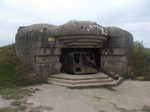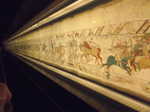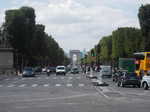Home » Adventures » Backpacking Europe » France
The European campaign of WWII, and especially D-Day, loom large in the collective memory of the United States so I was very excited to visit the Normandy beaches and D-Day sites. In Bayeux, the first French city liberated by the Allies, I visited its Commonwealth Cemetery. Wandering amongst the grave markers, mostly from the Battle of Normandy, was very moving. “June 6, 1944” was etched into so many of the stones belonging to men who were only 19 or 20 years old. It was impossible for me to comprehend what transpired and what they went through. The cemetery even had a section for Germans, which was built and maintained to the same standards as the Allies. This surprised me, but I learned the practice is common for Commonwealth Cemeteries.
Bayeux’s D-Day museum contained an enormous amount of detailed information on not only D-Day, but the entire battle for Normandy. After the incredible landings, intense fighting persisted for the next two months, pushing the front forward and linking towns. Both victories and defeats occurred as the Allies fought their way inland. So much information was contained within that I could not even read half of it, much less comprehend or remember it. The museum chronicled everything from the battles, to logistics, to the resistance, to hedge rows, and countless other details.

I took a guided tour of the D-Day landing sites, since they were not readily accessibly by public transport. Having a very knowledgeable guide explaining exactly what happened at these places was a nice bonus as well. As with almost any guided tour I felt a bit hurried through the sites, but not too rushed. Our first stop was the massive concrete bunkers of a German artillery bunker, whose guns fired on Allied ships on D-Day. I never realized reinforced concrete was so effective against the shells of those days, with a direct hit only chipping away at the concrete. One of these guns was only silenced when a shell literally came in through the opening in the front and exploded inside.
We then went to the immaculately maintained American Cemetery, where almost 10,000 Americans killed throughout the war were buried. This includes people not only killed on D-Day and in Normandy, but casualties throughout the war were moved to permanent cemeteries like this one after the fighting ended. Next of kin also had the option of bringing the body home, which around half the families did. Commonwealth soldiers, however, could not be returned home, and were buried near where they died, sometimes in small churchyard cemeteries. Wandering throughout the long lines of graves arranged in perfectly straight rows inside the American Cemetery was moving. People were interred without respect to their age, rank, or time or place of death. They are all recognized equally as making the ultimate sacrifice.
Next was Omaha Beach, where the Allied landing forces faced the most German resistance. I stood on the very beach where men had to cross hundreds of yards of open sand in the face of German gun fire. Hundreds died here securing the beachhead. Concrete bunkers for the machineguns were still on the hillside. I could see the sandbars and shelves that prevented some landing craft from reaching the beach, which resulted in people drowning after they disembarked and had to cross water that was eventually over their heads. I could not imagine those events occurring right here, especially since the beach has since been developed for recreation. Most veterans were happy with these changes, and a few monuments were along the shoreline too.
Our next stop was Point de Hoc, a strategic placement for German guns. Here Rangers famously scaled the hundred foot cliffs to attack a German gun position. The spot had been bombed extensively leading up to D-Day, so the Germans had hid the guns inland and only decoy logs were there when the Allies landed. The Ranges did find and disable the real guns though. They did not lose a man during the assault, but suffered heavy loses holding the point, as they were not relieved for 2½ days. The landscape still had numerous scars and craters from the Allied bombardment, with large bomb holes all over the place.
We also passed by the thick, dense, and deadly hedgerows. They were along almost every road and separating most fields. They severely limited visibility and provided great defensive positions for the Germans.
I also learned that thousands of French civilians were killed during the Normandy campaign. No warnings about Allied air raids to disrupt German reinforcements could be given to those living in strategically located towns without also alerting the enemy, so bombs fell with people still unaware and in their homes.

I walked along the seventy meter long Bayeux Tapestry to see the story of William the Conquer’s conquest over the English. The sewn mural, whose final panels were lost, told in amazing detail the tale from Harold being take prisoner in France to William’s victory at the battle of Hastings. It showed kings, but also the work of ordinary soldiers building boats. This embroidery’s real purpose though was to tell a morality story, as it hung in a church. Harold, who was defeated in England, reneged on an oath of loyalty he swore on holy relics to William. Harold’s defeat and death show the horrible consequences of breaking a sacred vow.
Bayeux’s Cathedral was being illuminated at night, so I visited it in the evening to admire the show. Besides a church lit in beautifully changing colors, I was also pleasantly surprised to find a free concert inside. I sat in the massive cathedral (whose interior was very similar to the more famous Westminster, Notre Dame, and others), enjoying its organ and the talented choir.
The Cathédrale Notre Dame de Paris lived up to its hype as I admired its sweeping arches, gargoyles, and statues. When it was first built over half a millennia ago, it must have been so much more striking as it towered over the city. The inside was as impressive, with towering ceilings and massive stained glass windows. I also climbed to the top of Notre Dame. Seeing the gargoyles at such close range was neat. The detailed sculptures were of all kinds of evil creatures, including one which biting the head off a chicken. Unfortunately Notre Dame’s large bells were undergoing renovations, so I could not see them or do Quasimodo impressions. The final climb to the top of the bell tower gave nice views of the city, but nothing compared with the Eiffel Tower.
The inside of Sainte-Chapelle, a chapel that was once exclusively used by kings, had impressive, original stain glass windows inside. They were massive and covered all the walls from floor to ceiling of this large room. The windows were composed of many different panels, each depicting a Bible story. The individual stain glass must have taken a considerable about of work, but seeing any details on the ones located very high up was near impossible. Without a cheat sheet, knowing which story each panel corresponded to would also have been difficult.

I did not go inside the Louvre. I had just visited the National Galley in London a few days before, and do not find most art that captivating anyway. I did not want to spend the Euros to fight the crowds basically just to see the Mona Lisa. I instead lounged in the courtyard, admiring the old buildings and modern glass pyramid.
I strolled up the wide, tree-lined Avenue des Champs-Élysées toward the Arc de Triomphe, passing many sculptures, fountains, and public art along the way. The Arc was in the center of a giant plaza, now a traffic circle. It was a towering monument to Napoleon’s victories, with grand carvings of battles and soldiers on every face. They were very high above the ground though, making any details very difficult to see.

The Eiffel Tower and surrounding park were very impressive. There was of course a line to go to the top, but after about an hour and an elevator transfer I found myself at the top. The views were even more awe inspiring than I expected. Paris is generally a very short city, so my line of sight was unobstructed from atop the tower. The crisscrossing avenues looked like veins running through the buildings. Most of the famous landmarks were easy to locate and identify. I really enjoyed my time at the top.
I came back later at night to admire the Eiffel Tower in its illuminated glory. I sat in the park admiring this beauty, while reading a book and declining random people selling bottles of wine. I waited for the top of the hour light show, which was less than spectacular. The tower sparkled for a few minutes with extra lights flashing on and off, but the extra pizzazz did not add to the sight.
The line for the Catacombs moved excruciatingly slow, but I eventually got underground into the old mines under the city. A few elaborate carvings and wells created by the miners were along the route, before I reached the more famous human bones. In the late 1700s they had been transferred down here from above ground cemeteries for both space and health reasons. Skulls and femurs were stacked head high, and extended deep back into the caverns. They were neatly arranged along the pathway, but I was not sure if the order continued out of sight. About six million people are entombed down there. The anonymous piles of bones were quite a change from the elaborate grave markers in the cathedrals I had been visiting. These bones were only identified by the cemetery from which they had been relocated.